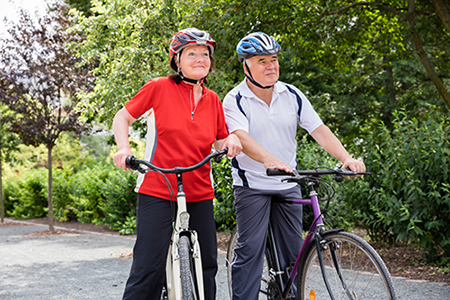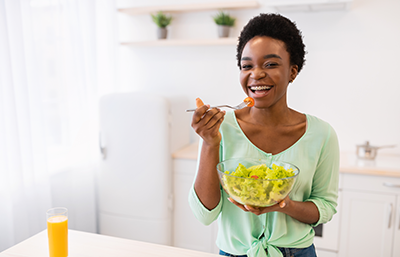

Health Habits
Physical Activity and Healthy Eating
What's Good for Your Body is Good for Your Mind!
Physical Activity and Healthy Eating are important Health Habits to promote wellbeing. These two lifestyle factors are critical to promote health, prevent chronic disease and improve wellbeing. To learn more, click on the tabs for Physical Activity and Healthy Eating below.

 Why?
Why?
Staying physically active is one of the best things you can do for your brain and your body. Research shows that physical activity is a strong promoter of neuroplasticity - your brain's ability to grow and form new connections. We now know that brains continue to grow, develop, and make connections no matter what age we are. Exercise boosts your brain's resilience: the ability to cope with stress and challenges and bounce back from tough times.
Did You Know?
Regular physical activity promotes:
- Lower risk of chronic disease, including heart disease, high blood pressure, diabetes, stroke, and cancer
- Improved function and independence
- Better quality of sleep
- Improved overall mood
- Increased longevity
- Lower risk of dementia, disability and falls as we age
Staying physically active is a key part of optimal aging. Ideally all adults would be physically active (getting our heart rate up or even breaking a sweat) at least 30 minutes 5 times a week. But the good news is you just have to move, and any kind of activity will benefit your health! Here are some ideas to help you increase your physical activity level.
Ideas to Get Started!
Just move: Many health problems are associated with sitting for long periods of time. By getting up and moving, you can improve your heart, bone and brain health and increase longevity.
Walk: Regular walking can improve and protect your mood, reduce anxiety, increase longevity, and decrease the risk of dementia as you age.
Do more of what you normally do: Daily activities such as errands, getting groceries, household chores, gardening and walking the dog can all add to your level of physical activity, and keep you independent and strong for the long term.
Join your local fitness of community centre: Conditioning programs are great for improving your cardiovascular fitness, but they also improve self-image, energy, and maintain cognitive health. A personal fitness assessment is really helpful at any age to work on what's best for your health.
Try something new: There are many activities out there that may be just right for you. Yoga, tai chi and qi gong are some examples of mind-body exercises that can improve your quality of sleep and energy levels and may be available at a local community centre or online.
Practice balancing: Activities that improve your co-ordination and balance can decrease your risk of falls. The better your balance, the more likely you are to stay independent over the long term.
Talk to your doctor or nurse practitioner: Learn what activities are best for you by having a chat with your primary care provider.
Set a Valued Goal!

 Why?
Why?
Healthy eating promotes wellness, and prevents disease. 85% of chronic diseases –like cancer, diabetes, stroke, pain, heart disease and dementia-- are caused by unhealthy lifestyles. To prevent or reverse lifestyle-related chronic disease, eat minimally processed food and plant-based foods: vegetables, fruits, whole grains, legumes, nuts and seeds.
Did You Know?
What is good for your heart is also good for your head!
- Omega-3 fatty acids (cold-water fish) can enhance learning and memory
- Folic acid (in spinach and orange juice) is essential for proper brain function
Healthy eating is not only about the foods you eat. It is also how you relate to your food. How slowly and how much do you eat? How much do you enjoy your food? Do you eat with others? Do you have mostly homecooked meals? Balancing food with your activity level is a simple way to improve healthy eating. Eat regular meals that balance calories in with calories out. Try to eat more during the day time when you are most active and less in the evening when you are less active. Going all day on a few calories makes it harder to stop eating in the evening. Your body is making up for having an empty tank in the day. Eating small portions more slowly and without distractions allows you to enjoy your meal more and stop eating before you become overfull. It can take 10 minutes after eating for your mind to realize you are full. Being mindful of how, why, when and where you eat will improve how you relate to your food. Notice thoughts, feelings and emotions you have when eating. Note smells and textures of food, and what you enjoy most. Brazil recently developed a guide to healthy eating that focuses on food behaviours. These recommendations are worth sharing:
10 Steps to a Healthy Diet:

- Make natural or minimally processed foods the basis of your diet
- Use oils, fats, sugar, and salt in small amounts
- Limit consumption of processed foods and drinks
- Avoid ultra-processed foods
- Eat regular meals in appropriate environments and eat with others. Avoid snacking or treating a meal as a snack
- Shop where you can get a variety of natural foods
- Develop, practice, and share cooking skills
- Plan your time to make food and eating important in your life – it’s for your well-being and longevity
- Away from home, choose places that serve freshly-made food
- Be wary of food marketing
Remember when it comes to healthy eating, what works is what is doable for you.
You can start at any time to make one small change to create healthier food habits.
Ideas to Get Started!
Check out Canada’s Food Guide: Reading these guidelines is a good place to start to increase your food awareness.
Add in one more fruit or vegetable a day: Simply adding more colourful fruits and vegetables to your diet will move you in the right direction!
Add more water to your day: Keep a drinking bottle near to sip water through the day. It makes a big difference!
Try mindful eating: Try a mindful eating exercise. Eat slowly, without any distractions. Pay attention to how the food tastes and feels in your mouth.
Keep a food diary for a day or a week: Track the food you eat for a week or even a day, to monitor your habits. You might notice you tend to look for a sweet snack in the evening – a small health goal could be swapping that cookie for some fruit!
Create a meal plan for a day or a week: You may find yourself eating unhealthy food, like take-out or a frozen pizza, because you are unsure what to make for dinner. By creating a healthy meal plan, you will not be left wondering what to eat!
Set a Valued Goal!

Set a valued SMART goal from the Ideas to get Started list, or choose one of your own. Remember the more specific, measurable and realistic your goal, the more likely you are to succeed!
Invitation: We invite you to try out The Wellness App to track your goal over the next 4 weeks. No goal is too small and The Wellness App will encourage you along the way!
Explore Further!
Still not sure what to do?
Learn more about the science behind Health Habits in Evidence section and explore these links:
![]() Physical Activity
Physical Activity
- Exercise Prescriptions - A series of exercise handouts that healthcare providers and patients can use to begin exercises beneficial for different medical illnesses
- Canadian Physical Activity Guidelines and Canadian Sedentary Behaviour Guidelines - A summary of the current Canadian guidelines on how much exercise individuals should be getting
- Reframe Health Lab: 23 and 1/2 hours - An educational video discussing about how much exercise is really needed to reduce the risk of chronic disease
- Yoga with Adriene - An instructional yoga channel with videos for people of all level
![]() Healthy Eating
Healthy Eating
- The Nutrition Source - A collection of resources about different nutrients and how much should be included in your meals
- Canada's Food Guides and Healthy Eating - Learn more about healthy eating recommendations. Healthy eating is more than the foods you eat. It is also about where, when, why and how you eat
- Mindful Eating Help Guide - Learn more about mindful eating, an evidence-based practice that helps not only improve your diet, but also your mindfulness







